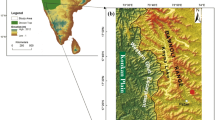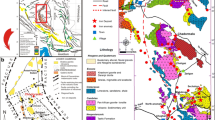Abstract
The dominant magnetic minerals and carriers of magnetic signals within the Chinese Loess Plateau are magnetite, maghemite, hematite, and goethite. In this study, we investigated the provenance and evolution of magnetic minerals during loess pedogenesis, using X-ray diffraction (XRD) and optical and electron microscopy, including field emission scanning electron microscopy (FESEM) and high-resolution transmission electron microscopy (HRTEM). Our results reveal that single- and multiphase mineral assemblages among magnetic minerals in the loess-paleosol sequence have been formed. Partial oxidation of coarse eolian magnetite has occurred in the desert source area and the oxidation degree is enhanced after deposition of the dust upon the Chinese Loess Plateau. This mode of origin resulted in a microtexture consisting of an inner magnetite core surrounded by a hematite rim, and strongly affected the magnetic characteristics of the loess. Goethite coexists with hematite in the loess and paleosol, and nanometer-scale hematite is formed upon goethite rims via dehydration. Our study provides direct mineralogical evidence of the magnetic record and paleoclimatic implications of the loess-paleosol sequence of the Chinese Loess Plateau.
Similar content being viewed by others
References
Ding Z L, Derbyshire E, Yang S L, et al. Stacked 2.6-Ma grain size record from the Chinese loess based on five sections and correlation with the deep-sea δ18O record. Paleoceanography, 2002, 17: 1033, doi:10.1029/2001PA000725
Chen J, An Z S, Wang Y J, et al. Distribution of Rb and Sr in the Luochuan loess-paleosol sequence of China during the last 800 ka. Sci China Ser D-Earth Sci, 1999, 42(3): 225–232
Chen J, Chen Y, Liu L, et al. Zr/Rb ratio in the Chinese loess sequences and its implication for changes in the East Asian winter monsoon strength. Geochim Cosmochim Acta, 2006, 70: 1471–1482
Ding Z L, Yang S L, Sun J M, et al. Iron geochemistry of loess and red clay deposits in the Chinese Loess Plateau and implications for long-term Asian monsoon evolution in the last 7.0 Ma. Earth Planet Sci Lett, 2001, 185: 99–109
Sun D H, Chen M Y, Shaw J, et al. Magnetostratigraphy and paleoclimatic interpretation of late Cenozoic eolian sediments from Chinese Loess Plateau. Sci China Ser D-Earth Sci, 1998, 28(1): 79–84
Ding Z L, Xiong S F, Sun J M, et al. Pedostratigraphy and paleomagnetism of a ∼7.0 Ma eolian loess-red clay sequence at Lingtai, Loess Plateau, north-central China and the implications for paleomonsoon evolution. Palaeogeogr Palaeoclimatol Palaeoecol, 1999, 152: 49–66
Guo Z T, Ruddiman W F, Hao Q Z, et al. Onset of Asian desertification by 22 Myr ago inferred from loess deposits in China. Nature, 2002, 416: 159–163
Chen T H, Xu H F, Ji J F, et al. Formation mechanism of ferromagnetic minerals in Loess of China: Tem investigation. Chin Sci Bull, 2003, 48(20): 2259–2266
Chen T H, Xu H F, Xie Q Q, et al. Characteristics and genesis of maghemite in Chinese loess and paleosols: Mechanism for magnetic susceptibility enhancement in paleosols. Earth Planet Sci Lett, 2005, 240: 790–802
Xie Q Q, Chen T H, Ji J F, et al. The distribution of palygorskite in Lingtai section of Chinese Loess Plateau and its paleoclimate significance (in Chinese). Acta Petrol Mineral, 2005, 24(6): 653–658
Ji J F, Chen J, Lu H Y. Origin of illite in the loess fromthe Luochuan area, Loess Plateau, Central China. Clay Miner, 1999, 34: 525–532
Ji J F, Balsam W L, Chen J. Mineralogic and climatic interpretations of the Luochuan loess section (China) based on diffuse reflectance spectrophotometry. Quat Res, 2001, 56: 23–30
Deng C L, Shaw J, Liu Q S, et al. Mineral magnetic variation of the Jingbian loess/paleosol sequence in the northern Loess Plateau of China: Implications for Quaternary development of Asian aridification and cooling. Earth Planet Sci Lett, 2006, 241: 248–259
Heller F, and Evans M E. Loess magnetism. Rev Geophys, 1995, 33: 211–240
Liu Q S, Deng C L, Torrent J, Zhu R X. Review of recent developments in mineral magnetism of the Chinese loess. Quat Sci Rev, 2007, 26: 368–385
Deng C L, Zhu R X, Verosub K L, et al. Mineral magnetic properties of loess/paleosol couplets of the central loess plateau of China over the last 1.2 Myr. J Geophys Res, 109, B01103, doi: 10.1029/2003JB002532, 2004
Heller F, Liu T S. Magnetism of Chinese loess deposits. Geophys J R Astr Soc, 1984, 77: 125–141
Beget J E, Stone D B, Hawkins D B. Paleoclimatic forcing of magnetic susceptibility variations in Alaskan loess during the late Quaternary. Geology, 1990, 18: 40–43
Guo B, Zhu R X, Roberts A P, et al. Lack of correlation between paleoprecipitation and magnetic susceptibility of Chinese loess/paleosol. Geophys Res Lett, 2001, 28(22): 4259–4262
Rutter N, Ding Z L, Evans M E, et al. Magnetostratigraphy of the Baoji loess-paleosol section in the North-Central China loess plateau. Quat Int, 1990, 7/8: 97–102
Liu Q S, Jackson M J, Banerjee S K, et al. Mechanism of magnetic susceptibility enhancements of the Chinese loess. J Geophy Res, 2004, vol. 109, B12107, doi:10.1029/2004JB003249
Kleteschka G, Banerjee S K. Magnetic stratigraphy of Chinese loess as a record of natural fire. Geophys Res Lett, 1995, 22: 1341–1343
Zhou L P, Oldfield F, Wintle A G, et al. Partly pedogenic origin of magnetic variations in Chinese Loess. Nature, 1990, 346: 737–739
Singer M J, Verosub K L, Fine P, et al. A conceptual model for the enhancement of magnetic susceptiblity in soils. Quat Int, 1996, 34–36: 243–248
Maher B A, Thompson R. Mineral magnetic record of the Chinese loess and paleosols. Geology, 1991, 19: 3–6
Evans M E, Heller F. Magnetic enhancement and palaeoclimate: Study of a loess/palaeosol couplet across the Loess Plateau of China. Geophys J Int, 1994, 117: 257–264
Sun J M, Liu T S. Multiple origins and interpretations of the magnetic susceptibility signal in Chinese wind-blow sediments. Earth Planet Sci Lett, 2000, 180: 287–296
Liu X M, Xia D S, Liu D S, et al. Discussion on two models of paleoclimatic records of magnetic susceptibility of Alaskan and Chinese Loess (in Chinese). Quat Sci, 2007, 27(2): 210–220
Zhu R X, Li C J, Wu H N, et al. Magnetic property of Chinese and its paleoclimate significance(in Chinese). Sci China Ser B, 1995, 38(2): 238–244
Heller F, Liu T S. Magnetism of Chinese loess deposits. J Geophy Res, 1987, 77: 125–141
Liu Q S, Banerjee S K, Jackson M J, et al. An integrated study of the grain-size-dependent magnetic mineralogy of the Chinese loess/paleosol and its environmental significance. J Geophys Res, 2003, 108(B9), 2437, doi:10.1029/2002JB002264
Liu Q S, Banerjee S K, Jackson M J, et al. New insights into partial oxidation model of magnetites and thermal alteration of magnetic mineralogy of the Chinese loess in air. Geophys J Int, 2004, 158: 506–514
Zhao Z Q, Liu C Q, Xiao Y K, et al. Geochemical study of boron isotopes in the process of loess weathering. Sci China Ser D-Earth Sci, 2003, 46(2): 106–116
Lu H Y, An Z S. Paleoclimatic significance of grain size of loess-palaeosol deposit in Chinese Loess Plateau. Sci China Ser D-Earth Sci, 1998, 41(6): 626–631
Kukla G, An Z S. Loess stratigraphy in central China. Palaeogeogr Palaeoclimatol Palaeoecol, 1989, 72: 203–325
Liu X M, Liu T S, Xu T C, et al. The Chinese loess in Xifeng: I. The Primary study on magnetostratigraphy of a loess profile in Xifeng area, Gansu Province. Geophys J R Astr Soc, 1988, 92: 345–348
Liu X M, Rolph T, An Z S, Hesse P. Paleoclimatic significance of magnetic properties on the Red Clay underlying the loess and paleosols in China. Palaeogeogr Palaeoclimatol Palaeoecol, 2003, 199: 153–166
Chen J, Ji J F, Balsam W, et al. Characterization of the Chinese loess∼paleosol stratigraphy by whiteness measurement. Palaeogeogr Palaeoclimatol Palaeoecol, 2002, 183: 287–297
Deng C L, Liu Q S, Pan Y X, et al. Environmental magnetism of Chinese loess-paleosol sequences (in Chinese). Quat Sci, 2007, 27(2): 193–209
Ji Junfeng, Chen Jun, Balsam William, et al. High resolution hematite/goethite records from Chinese loess sequences for the last glacial-interglacial cycle: Rapid climatic response of the East Asian Monsoon to the tropical Pacific. Geophys Res Lett, 2004, 31, L03207, doi:10.1029/2003GL018975
Xie Q Q, Chen T H, Sun Y B, et al. Ferric oxides compositions of the Luochuan loess-red clay sequences in China Loess Plateau and its paleoclimatic signicances. Acta Mineral Sin, 2008, 28(4): 389–396
Verosub K L, Fine P, Singer M J, et al. Pedogensis and paleoclimate: interpretation of the magnetic susceptibility record of Chinese loess-paleosol sequences. Geology, 1993, 21: 1011–1014
Deng C L, Vidic N J, Vernsub K L, et al. Mineral magnetic variation of the Jiaodao Chinese loess / paleosol sequence and its bearing on long-term climatic variability. J Geophy Res, 2005, 110: B03103, doi:10. 1029/2004JB003451
Balsam W, Ji J F, Chen J, et al. Climatic interpretation of the Luochuan and Lingtai loess sections, China, based on changing iron oxide mineralogy and magnetic susceptibility. Earth Planet Sci Lett, 2004, 223: 335–348
Gallagher K J, Feitknecht W, Mannweiler U. Mechanism of oxidation of magnetite to γ-Fe2O3. Nature, 1968, 217: 1118–1119
Van Velzen A J and Zijderveld J D A. Effects of weathering on single- domain magnetite in Early Pliocene marine marls. Geophys J Int, 1995, 121: 267–278
Cui Y, Verosub KL, Roberts AP. 1994 The effect of low-temperature oxideation on large multi-domain magnetite. Geophys Res Lett, 21: 757–760
Van Velzen A J and Zijderveld J D A. Low-temperature oxidation of magnetite in loess-paleosol sequences: A correction of rock magnetic parameters. Stud Geophys Geod, 1999, 43: 357–375
Honig J M. Analysis of th Verwey transition in magnetite. J Alloys Compounds, 1995, 22: 24–39
Ayyub P, Multani M, Barma M, et al. Size-induced structural phase transitions and hyperfine properties and microcrystalline Fe2O3. J Phys C: Solid State Phys, 1988, 21: 2229–2245
Deng C L, Vidic Natasa J, Verosub Kenneth J, et al. Mineral magnetic variation of the Jiaodao Chinese loess/paleosol sequences and its bearing on long-term clilmatic variability. J Geophy Res, 2005, 110, Bo3103, doi: 10. 1029/2004JB003451
Author information
Authors and Affiliations
Corresponding author
Additional information
Supported by National Natural Science Foundation of China (Grant Nos. 40772032 and 40573054) and National Basic Research Program (Grant No. 2007CB815603)
Rights and permissions
About this article
Cite this article
Xie, Q., Chen, T., Xu, X. et al. Transformation relationship among different magnetic minerals within loess-paleosol sediments of the Chinese Loess Plateau. Sci. China Ser. D-Earth Sci. 52, 313–322 (2009). https://doi.org/10.1007/s11430-009-0027-x
Received:
Accepted:
Published:
Issue Date:
DOI: https://doi.org/10.1007/s11430-009-0027-x




